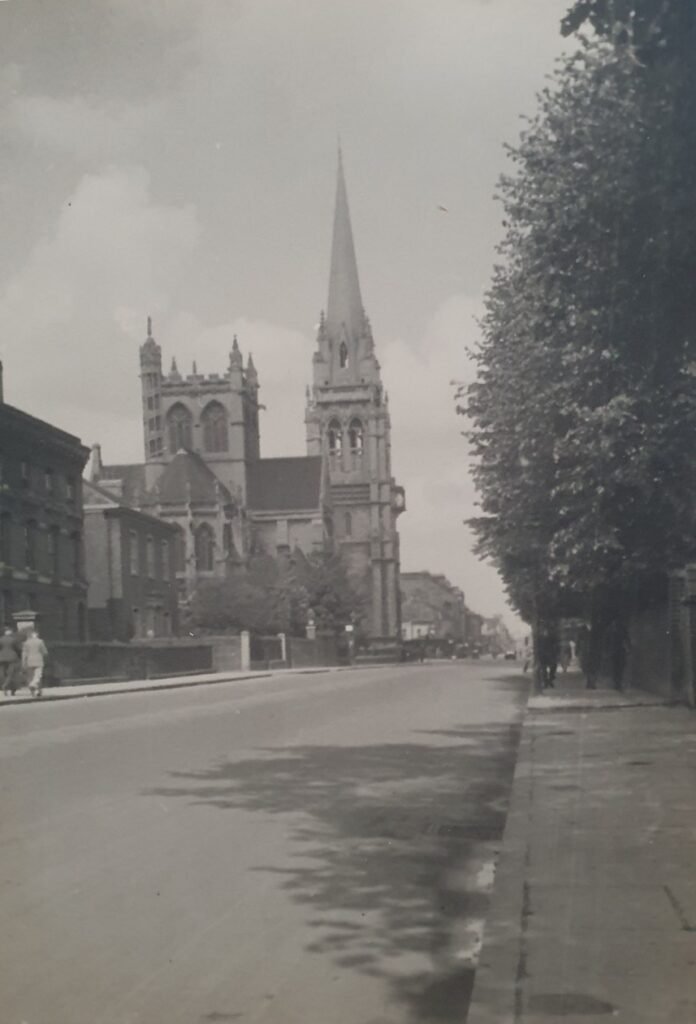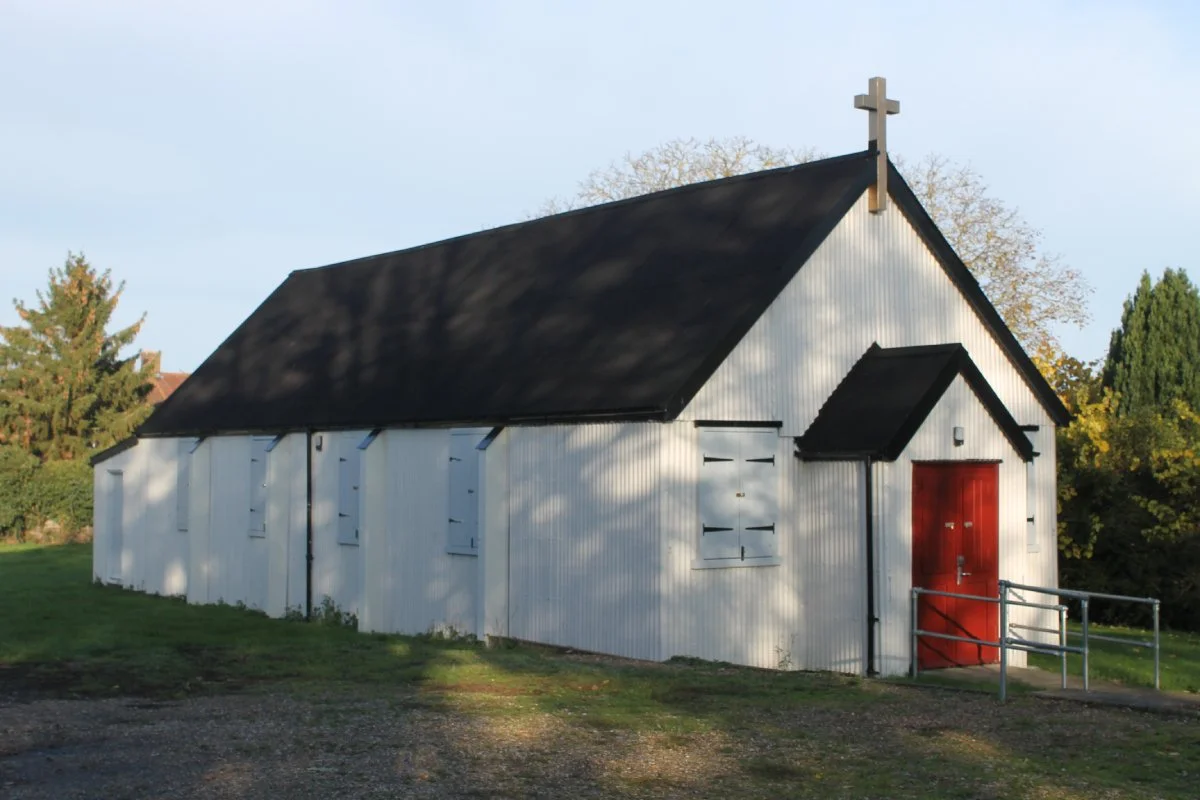Construction underway
Original ticket from the opening of The Church of Our Lady and the English Martyrs held by the Museum of Cambridge
Photograph of The Church of Our Lady and the English Martyrs c.1930
Funeral of Monsignor Christopher Scott (23 Feb 1922)
The History of Our Church
The Church of Our Lady of The Assumption and The English Martyrs (our full title) is situated in the heart of the city of Cambridge. An imposing example of the 19th Century Gothic Revival, it was built to the designs of Dunn & Hansom of Newcastle between 1885 and 1890, and founded solely by Mrs Yolande Marie Louise Lyne-Stephens, a former ballet dancer at the Paris Opera and Drury Lane, London, and widow of a wealthy banker.
It was on the feast of Our Lady of the Assumption that she promised to build the church, and Monsignor Christopher Scott – the first Rector – also wished to commemorate the Catholic Martyrs who died between 1535 and 1681, over thirty of whom had been in residence at the University.
Built by the Cambridge firm of Rattee and Kett , the church is constructed in Casterton, Ancaster and Combe Down Stone. It is a traditional cruciform structure in the early-decorated style with a large tower at the crossing, a polygonal apse and a west bell tower with a 65-metre spire, a landmark visible for miles around Cambridge. The approximate internal dimensions of the church are: length 48 metres [157ft] width across the aisles 16 metres [52ft] width at the transepts 22 metres [72ft], the height of the nave 15 metres [49ft].
Inside and over the west door stands the figure of Our Lady of the Assumption crowned with lilies and standing on the crescent moon with the vanquished serpent beneath. The west window shows the English Martyrs arranged in two principal groups, the clergy on the south side with St John Fisher in their midst and the laity on the north grouped round St Thomas More.
Beside the South aisle is an ancient statue of Our Lady with the Child Jesus. This statue is understood to be a gift in 1850 from Emmanuel College, which was built on the site of a Dominican Priory dating back to 1274. The Church of the Black Friars of Cambridge contained a statue of Our Blessed Lady to which much pilgrimage was made. Although unconfirmed this could be that statue.
The Chapel of the Holy Souls with the book of Remembrance is located at the west end of the south aisle. The sculpture above the altar depicts the solace and relief of the Holy Souls in Purgatory through the intercession of Our Lady and the angel who comforted Our Lord in Gethsemane.
The aisle windows were almost completely destroyed when the church was struck by a bomb on 1941, but were subsequently replaced in their original form. They epitomise the various sufferings of the English Martyrs, their being brought before the Council, racked, hung, drawn and quartered in the sight and sympathy of the faithful. The windows of the north aisle portray Carthusians, St Thomas Moore, B. Margaret Pole and others, while the south aisle is made a “Fisher Aisle”, devoted to scenes from the life of St John, Cardinal Bishop of Rochester, who in so many important ways is identified with Cambridge.
The best general impression of the interior is obtained from the gateway in the iron screen dividing the nave from the ante-chapel. The heads of the four great preachers of Our Lady’s Graces are carved in the four corners of the nave. The windows along the nave represent saints connected with the Church in Britain, arranged approximately in chronological order from east to west with a few additional figures in the eastern windows.
The Rood which is between the nave and the sanctuary is of the type known as “Majestas”; the figure of Our Lord, with glorified wounds, robed in alb, stole and pallium [as High Priest] and crowned [as King “reigning from the Tree”]. This was the earliest type of crucifix; the realistic figure, now almost universal, did not come into general use until the beginning of the thirteenth century. The cross, inspired by that at Nuremberg, is about 6 metres high, carved in oak; the figures of Christ and of Our Lady and of Saint John are of Kauri pine. They were carved locally by Mr. B. Maclean Leach and completed and blessed in 1914.
Beyond the present, modern altar is the High Altar with the relics of Saints Felix and Constantia, martyrs of the early Church. The tabernacle and ornaments of the altar are of exquisite French workmanship from Lyons. The baldacchino which covers the High Altar is similar to that over the tomb of Robert the Wise (1275-1343) at Santa Chiara, Naples. It is one of the earliest forms of adornment of a Christian altar. At the top is the figure of Our Lord in glory supported on each side by angels in act of adoration.
The design and the re-ordering of the sanctuary was done by Mr Gerard Goalen of Harlow after the Second Vatican Council. On 7th April, 1973, Bishop Charles Grant consecrated the present central altar. The original High Altar has subsequently been used mainly for reservation of the Blessed Sacrament.
You may also be interested in the following links:
The Parish Centre
This was originally the school building on the site. It opened in January 1868, replacing the original school which had existed in two cottages since 1843. It was extended by the addition of an infants’ classroom in 1894 but by the late 1920s had become completely out-of-date and was replaced by a new building in 1936.
It was used afterwards by the Catholic Mens Club until it reverted to school use in the 1950s to alleviate overcrowding.
It again became redundant when a new infants department was opened in the Rectory grounds in 1981 but after refurbishment was used as a Parish Hall.
A later refurbishment in 2009 converted the whole building into the Parish Centre.
The Church of St Vincent de Paul, Ditton
The Chapel of St Vincent de Paul, Ditton
The present building started life as part of the First Eastern General Hospital on Newmarket Road. At the end of WWI, a number of prefabricated war-surplus buildings were being disbanded. A benefactor, Baron Anatole Von Hügel, paid the cost –said to be £250 – and it was moved to the Rectory garden (now St. Alban’s School) in 1920, and named Houghton Hall. It served the Parish there until 1936. In 1939, it was re-erected in High Street, Chesterton and named St. Laurence’s.
Following the opening of a new St. Laurence’s Church on Milton Road in 1958, the ‘tin tabernacle’ was moved over the river and re-erected on Ditton Lane. For many years it was in a very precarious condition, until Mgr. Anthony Philpot invited the then Parish Architect to provide a design for re-ordering. “The result was a dramatic and wonderful transformation. By turning everything round ninety degrees a quite different ambience for worship was created, and … it signalled a significant revival in that community’s life” (Modern Times,1960 – 1990, by Mgr Anthony Rogers in: Catholics In Cambridge, edited by Nicholas Rogers, 2003).





